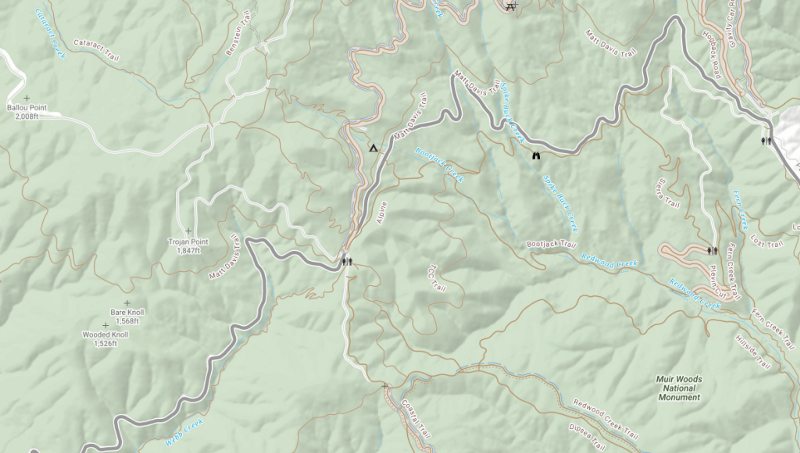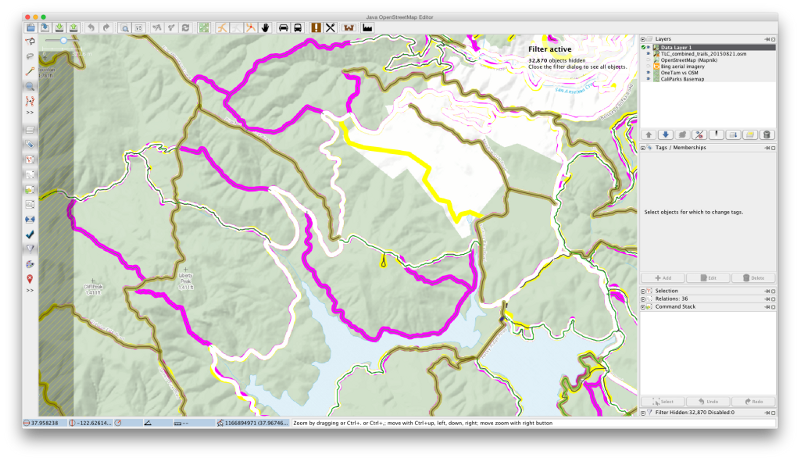Turning bad social data into good information helps parks, the open mapping community, and salmon

When we launched CaliParks.org, we created a custom base map especially to emphasize parks rather than the city names and highways that dominate most basic online maps.
We made sure to pull all the park boundaries and names from the California Protected Areas Database (calands.org). That’s the nation’s most complete set of statewide parks data, so we’re confident those are as good as any group of 11,826 things can be. (Yes, California has that many publicly accessible parks and open spaces!)
But, we wondered, what about what’s inside parks? How could we show the trails and other amenities inside all those parks?
It wasn’t possible to contact the nearly one thousand agencies that manage our parks and get their official data one-by-one. So we did what many web developers do. We went to OpenStreetMap, the largest and most detailed publicly available map of the world ever made.
Soon after we launched the first version of CaliParks last year, we heard from the folks who manage the Marin Municipal Water District and the Marin County Parks District. In the well-loved—and very heavily used—lands surrounding Mount Tamalpais, they told us we were showing unauthorized trails on our map. Some of those trails are more than just unauthorized. Using them causes erosion that damages habitat, including for endangered coho salmon.
That’s serious stuff. And we care about protecting our public lands and the species that share our habitats, too. Because there was no quick fix for specific trails, we temporarily removed all trails data from CaliParks.org so that we could work on a solution with park and trail managers.
From there, we took it as our mission to research options for dealing with this problem, which we learned is very common in the world of parks, where unauthorized trails are usually referred to as “social trails” — people make them informally, sometimes to grab a view from a summit or cut across a switchback.
In some ways, social trails are not unlike social media: At its best, the crowd finds the best possible route from A to B. But other times, it’s more like the meme you wish you could un-see: Oh, don’t go there!
So, we joined with Trailhead Labs to attend a hackathon at the Department of Interior in Washington, DC, last spring, where solving the problem of social trails in OSM was our chosen mandate. And then we presented some of that work at a “Partners Outdoors” meeting held by the U.S. Forest Service last summer.
The core challenge with social trails in the past has been that the most obvious “solution” — deleting the trails from OpenStreetMap — is not likely to work in the long run. The OSM map is made by a diverse group of editors. Some work from experience on the ground. Some edit the map based on aerial photos. If you delete unauthorized trails from the map, they’re likely to get added back by a later editor who thinks the data is simply missing.
So, instead of degrading the completeness of the map, we enriched it by changing how the trails are tagged. Instead of simply being labelled “paths,” they can now be labelled “social_paths,” and just like that, anyone who uses OSM to create a map, such as CaliParks, can use the new tag to filter out unofficial trails. On the off chance that someone else is using the data for another purpose — perhaps even studying the impact of those social trails on wildlife and ecosystems — they too can benefit. (Update 3/25/16: See this post for a revision of methods based on OSM community feedback, though intent remains the same.)
We used some basic tools to make views where data mismatches pop out with potentially illegal trails in magenta:

Now, we’ve brought trails back onto our maps in CaliParks, and the CaliParks FAQ also documents how we can continue to improve trails and parks data as users find issues with the data. And, as always, one crucial value to this work is that when we edit OSM, the data gets better not just for CaliParks but also for anyone using OSM, including Mapbox.com and, soon, Facebook (for which Stamen has been developing a new custom basemap).
We are also spreading the word about how to use the “social_path” tag through social media, the OSM community, and in our work with other parks and public land agencies and grassroots groups such as Nerds for Nature and Maptime.
It was very gratifying to hear back from Matt Cerkel, a park ranger with the Marin Municipal Water District, who spurred us to take on this challenge. “Thanks for your work on this and listening to our concerns,” he said. “It is much appreciated!”
It was our pleasure, because we’re passionate about sharing care for the environment, too. We believe the more people who are involved with parks, and sharing their love for parks, the better. That’s what CaliParks is all about.
For a more technical how-to guide on patrolling trails and eliminating “social trails” from maps based on Open Streets Maps, click here.
Dan Rademacher is executive director of GreenInfo Network. He worked on CaliParks.org as a project director at Stamen Design.
